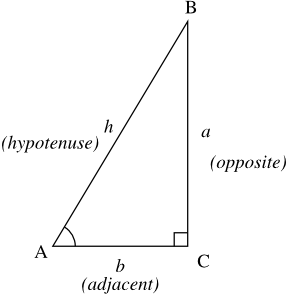What We Review
Introduction
Right triangles show up on nearly every SAT® Math exam. When a problem involves ladders, ramps, or slanted roofs, right triangle trigonometry is usually the hidden tool. By the end of this guide, students will be able to:
- Apply the Pythagorean Theorem with confidence
- Use SOH-CAH-TOA in both calculator and non-calculator sections
- Recognize and exploit 30-60-90 and 45-45-90 special right triangles
Therefore, score-boosting shortcuts will feel natural.
Pythagorean Theorem Refresher
A. Formula and Quick Facts
For any right triangle, the squares of the legs add to the square of the hypotenuse:
a^{2}+b^{2}=c^{2}
Key points:
- The hypotenuse is always opposite the 90^\circ angle.
- If two sides are known, the third follows quickly.
- Common SAT® leg lengths include 3-4-5, 5-12-13, and their multiples.
B. Common SAT® Twists
- Legs with radicals: 5\sqrt{2} often pairs with 5\sqrt{2} in isosceles right triangles.
- Missing hypotenuse in coordinate plane distance questions.
- Hidden right angles are created by altitude lines or slopes.
C. Example
Points A (–2, 3) and B (4, –1) form two vertices of a right triangle with the right angle at A. Find the length of the hypotenuse \overline{AB}.
Solution
1. Identify the legs using the distance in x and y directions.
- Change in x = |4 – (–2)| = 6
- Change in y = |–1 – 3| = 4
2. Because the right angle is at A, those lengths are legs. Therefore:
a=6,b=4
3. Apply the theorem:
6^{2}+4^{2}=c^{2}
36+16=c^{2}
52=c^{2}
c=\sqrt{52}=2\sqrt{13}
Meet SOH-CAH-TOA: The Core of Right Triangle Trigonometry
A. Defining Sine, Cosine, and Tangent
For an acute angle θ in a right triangle:
- Sine: \sin\theta=\dfrac{\text{opposite}}{\text{hypotenuse}}
- Cosine: \cos\theta=\dfrac{\text{adjacent}}{\text{hypotenuse}}
- Tangent: \tan\theta=\dfrac{\text{opposite}}{\text{adjacent}}
The mnemonic “SOH-CAH-TOA” summarizes these ratios.
B. Setting Up Ratios
First, label the triangle relative to angle θ. Next, assign each given length to the opposite, adjacent, or hypotenuse. Finally, substitute into the correct ratio.
C. Calculator vs. Non-Calculator Sections
- Non-calculator: angles of 30^\circ, 45^\circ, 60^\circ dominate. Memorize their exact values.
- Calculator: Any angle may appear, yet set the device to degree mode.
D. Example
Problem
In right triangle RST, m\angle T = 90^\circ and leg RS = 8 cm. If m\angle R = 37^\circ, find RT to the nearest tenth.
Solution
Use the cosine function:
\cos(\angle R) = \dfrac{\text{adjacent}}{\text{hypotenuse}} = \dfrac{RT}{RS}Substitute the known values:
\cos(37^\circ) = \dfrac{RT}{8}Now solve for RT:
RT = 8 \times \cos(37^\circ) RT \approx 8 \times 0.7986 = 6.4 \text{ cm}Complementary Angles: The Sine-Cosine Link
Because the acute angles in a right triangle are complementary, \theta + (90^{\circ}-\theta)=90^{\circ}. Consequently,
\sin\theta=\cos(90^{\circ}-\theta)\cos\theta=\sin(90^{\circ}-\theta)Quick Example
If \cos25^{\circ}=0.9063, then \sin65^{\circ} must also equal 0.9063. No calculator required!
Special Right Triangles Cheat Sheet
A. 45-45-90 Triangles
- Pattern: sides are x,,x,,x\sqrt{2} (legs, leg, hypotenuse).
- Derivation: An isosceles right triangle splits a square diagonally.
- Example
- Problem
- The legs of an isosceles right triangle measure 7 cm. Find the hypotenuse.
- Solution
- c=7\sqrt{2}\text{ cm}.
- Problem
B. 30-60-90 Triangles
- Pattern: x,;x\sqrt{3},;2x (short leg, long leg, hypotenuse).
- Derivation: drop an altitude in an equilateral triangle of side 2x.
- Example
- Problem
- The long leg of a 30-60-90 triangle is 9\sqrt{3}. Determine the other two sides.
- Solution
- Long leg = x\sqrt{3} → x=9.
- Short leg = x=9; hypotenuse = 2x=18.
- Problem
Using Similarity to Build Exact Trig Values
By placing special right triangles on the unit circle, exact ratios follow.
| Angles | Sine | Cosine | Tangent |
| 30^\circ | \dfrac{1}{2} | \dfrac{\sqrt{3}}{2} | \dfrac{\sqrt{3}}{3} |
| 45^\circ | \dfrac{\sqrt{2}}{2} | \dfrac{\sqrt{2}}{2} | 1 |
| 60^\circ | \dfrac{\sqrt{3}}{2} | \dfrac{1}{2} | \sqrt{3} |
Example
Find \sin45^{\circ}.
Solution: In a 45-45-90 triangle with legs 1, hypotenuse \sqrt{2},
\sin45^{\circ}=\dfrac{1}{\sqrt{2}}=\dfrac{\sqrt{2}}{2}
Strategy Section: Which Tool When?
Decision bullets guide quick choices:
- Need a missing side and have the other two? → Use Pythagorean Theorem.
- Know one side and one non-right angle? → Apply SOH-CAH-TOA.
- Angle equal to 30^\circ, 45^\circ, 60^\circ? → Special triangle shortcuts save time.
- Asked for exact value, not decimal? → Prefer special triangles or similarity.
Timed-test tips: Write the SOH-CAH-TOA letters on scrap paper immediately; it prevents mix-ups under pressure.
Real-World & SAT®-Style Applications
1. Angle of Elevation
Problem
A surveyor stands 40 m from a tower. The line of sight to the top forms a 33^\circ angle of elevation. Estimate the tower’s height to the nearest meter.
Solution
Opposite = height, adjacent = 40 m.
\tan33^{\circ}=\dfrac{h}{40} → h=40\tan33^{\circ}\approx40(0.649)=26\text{ m}2. Coordinate Plane Tie-In
Problem
Triangle PQR has right angle at Q with Q(3, –2) and R(7, 5). If PQ = 5, find PR.
Solution
- Find QR using distance formula:
- Δx = 7 – 3 = 4, Δy = 5 – (–2) = 7 → QR=\sqrt{4^{2}+7^{2}}=\sqrt{65}.
- Apply the Pythagorean Theorem to the triangle:
- pq^{2}+(QR)^{2}=(PR)^{2}
- 5^{2}+65=(PR)^{2}
- 25+65=90 → PR=\sqrt{90}=3\sqrt{10}.
Quick Reference Vocabulary Chart
| Term | Definition |
| Hypotenuse | The side opposite the right angle; longest side. |
| Opposite Side | The side across from a given acute angle. |
| Adjacent Side | The side next to a given acute angle (not the hypotenuse). |
| Altitude | A perpendicular segment from a vertex to the opposite side. |
| Angle of Elevation | The angle formed by a horizontal line and a line of sight upward. |
| Angle of Depression | The angle formed by a horizontal line and a line of sight downward. |
| Complementary Angles | Two angles whose measures add to 90^\circ. |
| Similar Triangles | Triangles with equal corresponding angles and proportional sides. |
Practice Questions
- A right triangle has legs 9 cm and 12 cm. Find the hypotenuse.
- In △XYZ, m\angle Y = 90^\circ, XY = 10 m, m\angle X = 28^\circ. Find YZ to the nearest tenth.
- Find \cos60^{\circ} using a special triangle.
- The hypotenuse of a 30-60-90 triangle is 14. What is the shorter leg?
- \angle A and \angle B are complementary. If \sin A=0.8, what is \cos B?
Answer Key with Brief Explanations
- 15
- 10\sin28^{\circ}\approx4.7\text{ m}
- \cos60^{\circ}=\dfrac{1}{2}.
- 7.
- 0.8.
Key Takeaways & Next Steps
- Memorize the Pythagorean triple patterns (3-4-5, 5-12-13).
- Keep SOH-CAH-TOA written out until it sticks.
- Special right triangles convert angles 30^\circ, 45^\circ, 60^\circ into speedy exact values.
- The sine of an angle equals the cosine of its complement.
- Practice daily; short bursts of study reinforce retention more than cramming.
Next, tackle official SAT® practice sets and time every attempt. With the strategies above, right triangle trigonometry will become a reliable strength. Good luck!
Sharpen Your Skills for SAT® Math (Digital)
Are you preparing for the SAT® Math (Digital) test? We’ve got you covered! Try our review articles designed to help you confidently tackle real-world SAT® Math (Digital) problems. You’ll find everything you need to succeed, from quick tips to detailed strategies. Start exploring now!
Need help preparing for your SAT® Math (Digital) exam?
Albert has hundreds of SAT® Math (Digital) practice questions, free response, and full-length practice tests to try out.










